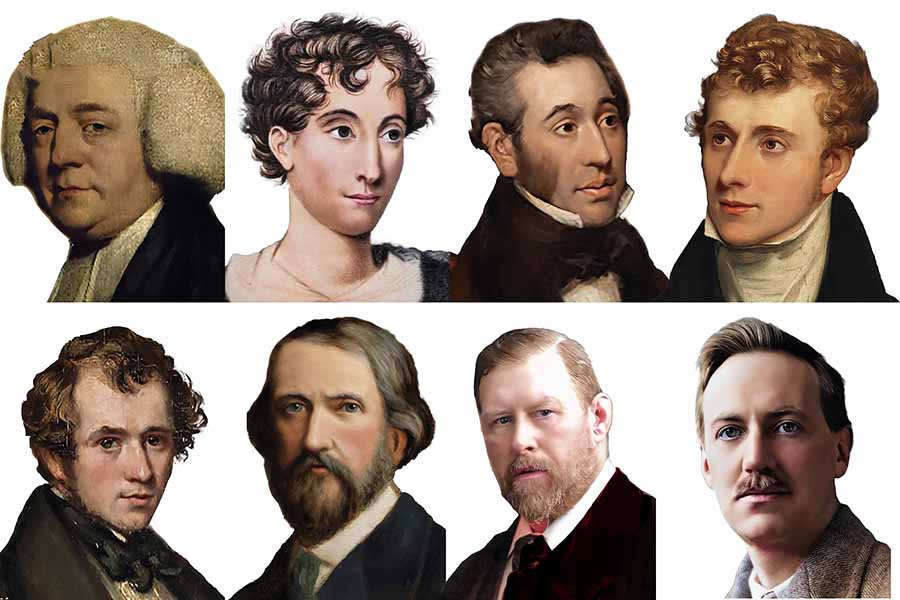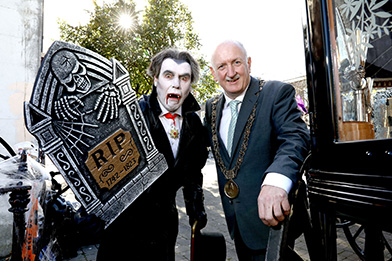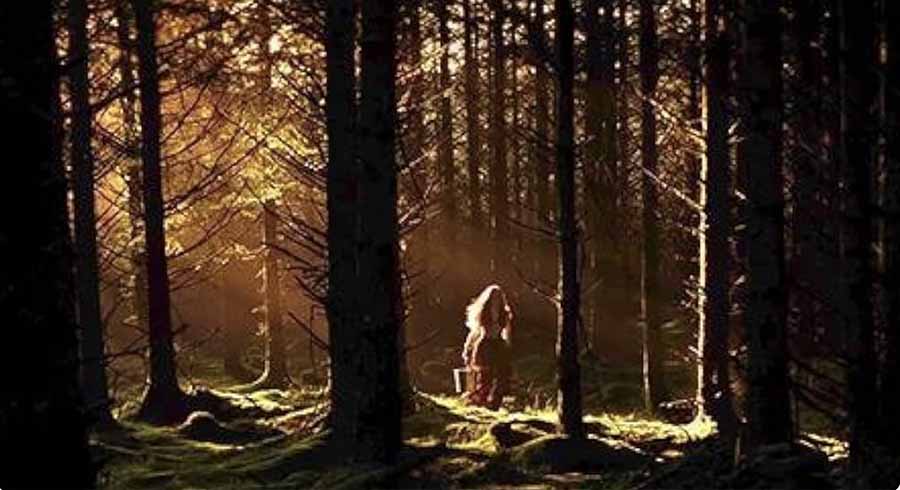
“As he was singing his prayer, he saw a misshapen, ugly monster athwart the path before him. This was the Evil Spectre with his black, ugly, misshapen household, human beings, to wit, in forms of spectres.” – Translation of Moiling ocus a Bhetae c1000AD.
(The birth and life of St Mo Ling, translated by Whitley Stokes).
Ni bíd ni fo díchlith dia ruse ó bri bruachaig, do sídaib nó samlaib, d’ almaib ocus d’ úathaib
There was nothing hidden from his eye, gazing from the spacious knoll, of fairy-folk or fetches, of herds, or goblins.
(Metrical Dindsenchas c1200 translated by Edward Gwynn)
The Gothic horror genre, with its brooding atmospheres, spectral apparitions, and labyrinthine explorations of the human psyche, has long been intertwined with the cultural and historical fabric of Ireland. From the mist-shrouded bogs and crumbling abbeys of its landscape to the ancient folklore that whispers of banshees, changelings, and restless spirits, Ireland has provided fertile ground for tales that delve into the uncanny and the macabre.
This trajectory of Irish horror writing illuminates the genre’s adaptability but also underscores how Irish Gothic has served as a mirror to the nation’s colonial traumas, religious schisms, and postcolonial anxieties.
At its core, Irish Gothic is distinguished by its postcolonial inflection. Unlike the English Gothic, which often romanticised medieval ruins as symbols of aristocratic decay, Irish variants frequently allegorise the Protestant Ascendancy’s precarious dominion over a Catholic underclass, haunted by the ghosts of dispossession and rebellion.
As critic Jarlath Killeen notes in The Emergence of Irish Gothic Fiction (2014), the genre emerged as an “Anglican response to historical conditions,” where Anglo-Irish authors exorcised repressed fears of Catholic resurgence through narratives of spectral invasion and moral retribution.
This tradition, merging mainland Europe’s 18th-century enlightenment with Ireland’s pre-modern folklore, evolved into a potent vehicle for national identity, influencing writers from Charles Maturin to Bram Stoker, and persisting through modernist reinventions by Elizabeth Bowen and William Trevor.
In the 21st century, this literary legacy has migrated to the screen, birthing a “New Wave of Irish Horror” that has garnered international awards and critical acclaim, from the BAFTA-nominated The Hole in the Ground (2019) to the Oscar-shortlisted The Banshees of Inisherin (2022), which, though not pure horror, echoes Gothic themes of isolation and the uncanny. Through this lens, Irish Gothic reveals itself not as mere escapism, but as a dialogue between past hauntings and present reckonings.
1700s: Seeds of Spectral Anxiety
The origins of Irish Gothic literature can be traced to the mid-18th century, a period of profound socio-political upheaval in Ireland. Following the Williamite War of 1691 and the punitive Penal Laws, the Protestant Ascendancy, Anglo-Irish landowners aligned with the Church of Ireland, held sway over vast estates, yet lived in perpetual dread of Catholic insurrection.
This “precarious control,” as described by Wikipedia’s entry on Irish Gothic literature, fostered a cultural psyche ripe for Gothic expression: a landscape where rational Enlightenment ideals collided with the irrational undercurrents of Irish folklore. The genre’s formal beginnings in Ireland predate London-born Horace Walpole’s seminal The Castle of Otranto (1764), often hailed as the first Gothic novel, with Irish precursors emerging as early as 1760.
Chasing the origins of Irish Gothic is worthy of a Gothic novel in itself, complete with a descent into the cellars with Bram Stoker of Sheridan Le Fanu holding a flaming torch. Ireland has recently been accorded the honor of publishing a foundational text, the anonymous The Adventures of Miss Sophia Berkley (1760), which predates Walpole and was problematically penned by an anonymous author, a “A Young Lady.” It was published in Dublin by the prominent Catholic printing firm of James Hoey, based on Castle Street. This has been contended in recent years to be largely a plagiarism of an earlier London (much less Gothic) publication, The History of Amanda (1758), albeit with a setting moved to Atlantic Kerry and fairy abductions which may have been reworked by Hoey himself. This novelette, championed by Dale Townshend in The Gothic Novel in Ireland, c. 1760–1829 (2018), features a persecuted heroine navigating haunted castles and tyrannical guardians, hallmarks of the Gothic mode.
Similarly, Thomas Leland’s Longsword, Earl of Salisbury: An Historical Romance (1762), written by an Irish Anglican clergyman, blends chivalric romance with proto-Gothic elements. Leland, critiqued for his History of Ireland from the Invasion of Henry II (1773), which portrayed Ireland as a barbarous “Gothic madhouse,” infused his fiction with anxieties over native “otherness.” In Longsword, medieval English knights confront spectral foes in Irish settings, allegorising the Ascendancy’s fear of historical recurrence, the “past that will not stay in the past,” a quintessential Gothic trope.
These early works were not isolated; they reflected broader Enlightenment debates. As Killeen argues, Irish Gothic arose from mid-18th-century political shifts, including the Patriot movement’s push for legislative independence, which heightened sectarian tensions. Folklore played a nascent role here, with Leland’s narratives echoing tales of the sídhe (fairy folk) as malevolent forces disrupting colonial order.
By the 1790s, amid the United Irishmen’s Rebellion, the genre gained momentum. Regina Maria Roche, born in Waterford in 1765, epitomised this phase with Clermont (1798), a sensation that outsold contemporaries like Ann Radcliffe’s The Mysteries of Udolpho. Roche’s tale of a heroine ensnared in a decaying French castle transposed Irish anxieties onto Continental settings, but its Irish provenance infused it with a rawer edge of Catholic diabolism.
Critics like Rolf and Magda Loeber, in their exhaustive A Guide to Irish Fiction, 1650–1900 (2006), document over 5,800 Irish novels from this era, many veering Gothic, underscoring the genre’s rapid proliferation.
Thus, the 1700s sowed the seeds of Irish Gothic not as mere imitation of English models, but as a distinctly postcolonial form, haunted by the ghosts of conquest and folklore’s unyielding grip. This foundation would propel the genre into its 19th-century zenith, transforming local terrors into international archetypes.
1800s: Folklore’s Macabre Muse and the Forging of Gothic Fiction

The 19th century marked the apogee of Irish Gothic, as writers harnessed the genre’s full potential to interrogate Ireland’s colonial plight. The Act of Union (1801), which dissolved the Irish Parliament and subsumed Ireland under English parliamentary rule, intensified feelings of cultural erasure. the memory of heaped corpses, with the suspicion that some were not yet dead, from the cholera epidemic of 1832 was a family memory for Bram Stoker’s mother. The mummified remains in Saint Mohican’s were also a Stoker influence as members of his family were buried in the nearby churchyard, while the Great Famine (1845–1852) unleashed waves of emigration and spectral imagery of starving ghosts.
Amid this turmoil, Irish authors, predominantly Anglo-Irish, drew voraciously from folklore, infusing Gothic fiction with banshees’ wails, pookas’ shape-shifting, and the dread dullahan (headless horseman), thereby elevating the genre beyond English precedents.
Foremost among these was Charles Robert Maturin (1780–1824), a Dublin curate whose Melmoth the Wanderer (1820) is often deemed the Irish Gothic’s masterpiece. This frame-tale novella follows the eponymous anti-hero, a Faustian figure damned for rejecting redemption, wandering centuries in pursuit of souls to ease his torment.
Maturin’s narrative sprawls across Europe and Ireland, incorporating folktale motifs like the fear gorta (hunger spirit) to symbolise colonial guilt. As Terry Eagleton observes in Heathcliff and the Great Hunger (1995), Melmoth allegorises the Ascendancy’s “remote aristocrats dominating an atavistic peasantry,” with the Wanderer’s isolation mirroring Protestant alienation. Influencing Balzac, Baudelaire, and even Oscar Wilde (who adopted the pseudonym Sebastian Melmoth) and who was a grand nephew, as Maturin marred his mother’s maternal aunt.
Joseph Thomas Sheridan Le Fanu (1814–1873), born in Dublin and later given the moniker “grandfather of Gothic,” refined this tradition with psychological depth, blending folklore and sensation fiction. His Uncle Silas (1864) transplants Radcliffean persecution to an Irish manor, but it is Carmilla (1872), a lesbian vampire novella set in Styria yet steeped in Irish lore, that endures. Carmilla, a seductive revenant preying on a young woman, draws from tales of the baobhan sidhe (fairy vampire) and leanansídhe (spirit muse), predating and inspiring Stoker’s Dracula. Le Fanu’s ghost stories, collected in In a Glass Darkly (1872), a final tour de force written a year before he died, evoke the “fires of lust ignited to precipitous extremes,” per Gothic conventions.
Bram Stoker (1847–1912), also Dublin-born, crowned this era with Dracula (1897). Though set in Transylvania, the novel’s DNA is quintessentially Irish: Count Dracula embodies the invasive “other,” akin to English fears of Irish Fenians, while his castle echoes Slainte ruins haunted by púcaí. Elizabeth Miller highlights how Stoker fused “folklore, legend, vampire fiction and the conventions of the Gothic novel,” with Mina Harker’s journal entries mirroring banshee prophecies. Stoker was a drama critic for newspaper co-owned by le Fanu and was a close friend of Oscar Wilde’s alcoholic older brother Willie. He frequented the Wilde family home in Merrion Square and has close to Oscar’s mother Jane, who kept a bust of her uncle by marriage, Charles Maturin, and frequently referred to him, although he was of a previous generation.
Catholic writers like Gerald Griffin (1803–1840) contributed too; his The Brown Man (1829) merges folklore’s fear liath (grey man) with Gothic tropes of plagiarism and belatedness, symbolising cultural oppression. The Banim brothers, John (1798–1842) and Michael (1796–1874), explored country Gothic in tales of spectral revenge, drawing from Munster folklore.
Lady Caroline Lamb nee Ponsonby (1785 -1828), from a hugely influential family with bases in Kildare and Kilkenny, usually prefixed by “the notorious,” in between marrying an English prime minister and having an affair with the poet Lord George Byron, wrote an influential gothic novel based on the irish rebellion in 1798. Glenarvon was published in 1816 to withering reviews and public acclaim. It helped inspire John Polidori’s vampire book published three years later by Byron’s physician. Like Sheridan Le Fanu’s Uncle Silas (published 1864), there are no undead characters in the book but the descriptions helped shaped later storytelling and place it in the Gothic canon.
The key players in the development of Irish Gothic intersected with dizzying frequency. Bram Stoker’s first theatrical review, fresh out of Trinity College, for Joseph Sheridan Le Fanu’s newspaper was a review of a stage presentation of the Vampyre, written by John Polidori but inspired by Carolline Ponsonby, whose former lover was with Polidori when the story was written (Stoker was uniimpressed, and noted the stage machinery malfunctioned).
This era’s folklore infusion was no accident. As the Oxford Bibliographies on Irish Gothic Tradition notes, writers like Le Fanu and Stoker accessed collections by the Irish Folklore Commission, transforming oral traditions into literary horrors that humanised the “diabolical Other” of earlier texts. By century’s end, Irish Gothic had not only led the genre, exporting vampires and wanderers worldwide, but also paved the way for modernist reinventions, as the Big House novel decayed into 20th-century hauntings.

Inventing Lovecraft
Edward Plunkett, 18th Baron of Dunsany (1878–1957), writing as Lord Dunsany, enriched Irish Gothic horror by infusing it with mythic grandeur, Irish folklore, and a modernist sensibility, paving the way for both literary and cinematic descendants. His work, though less overtly horrific than Dracula, expanded the genre’s boundaries, ensuring its adaptability in Ireland’s haunted cultural landscape through his pioneering work in fantasy and supernatural fiction, which intersected with and expanded the Gothic mode.
Dunsany’s work, particularly in collections like The Gods of Pegāna (1905) and Time and the Gods (1906), introduced a proto-cosmic horror that expanded the Gothic beyond its traditional haunted castles and psychological terrors. His invented mythologies, populated by capricious gods and surreal realms, evoked the sublime dread central to Gothic literature but shifted it to an existential plane. In tales like “The Fortress Unvanquishable, Save for Sacnoth” (from The Sword of Welleran, 1908), a hero battles a demonic entity in a nightmarish fortress, blending Arthurian romance with Gothic horror’s oppressive settings. This cosmic scope, where human agency is dwarfed by incomprehensible forces, prefigures Lovecraft’s Cthulhu Mythos, which explicitly acknowledges Dunsany’s influence. Interest in Plunkett was rekindled by the 2008 film Dean Spanley, starring Peter O’GToole and based on his story, about an eccentric clergyman who believes he is the reincarnation of a dog
His short stories, such as “The Hoard of the Gibbelins” (from The Book of Wonder, 1912), depict doomed quests for cursed treasure in eerie landscapes, mirroring the Gothic’s fascination with decay and forbidden knowledge. This stylistic departure from the verbose sensationalism of 19th-century Gothic (e.g., Bram Stoker’s Dracula) offered a subtler, modernist inflection, aligning with Elizabeth Bowen’s later psychological hauntings. Critics note that Dunsany’s “elegiac tone” and “dreamlike dread” brought a new texture to the genre, influencing the atmospheric horror of 20th-century Irish writers like W.B. Yeats, whose Celtic Twilight shares Dunsany’s mythic preoccupations.
One of the writers that Plunkett influenced was HP Lovecraft, later to become a titan of the horror genre. One of Lovecraft’s first commissions was to write an Irish horror story for the Boston Hub Club. The Moon-Bog was basically a rewrite of Plunkett’s The Curse of the Wise Woman, also set in Meath, where Lovecraft never visited but where the Plunkett family home was located: “Somewhere, to what remote and fearsome region I know not, Denys Barry has gone. I was with him the last night he lived among men, and heard his screams when the thing came to him; but all the peasants and police in County Meath could never find him, or the others.”
The Boston boys did not know that the obscure writer they paid was a virulent anti Irish racist, someone who appeared to live in genuine fear of the Anglo-Saxon bloodline becoming tainted with corrupting influences That year he wrote to a friend:
“If the Irish had the ‘right’ to independence they would possess it. If they ever gain it, they will possess it – until they lose it again. England has the right to rule because she does. It is not chance, but racial superiority, which has made the Briton supreme.”
At the conclusion of The Rats in the Walls (1923), the unfortunate anti-hero Delapore descends into a condition of savagery.Lovecraft illustrates his downfall by having him regress from speaking Middle English and Latin to speaking degenerate Irish or Scottish Gaelic (which he confused for Irish): “Dia ad aghaidh ‘s ad aodánn agus bás dunach ort.”
1900s: Modernist Echoes and Postcolonial Phantoms

The 20th century witnessed Irish Gothic’s metamorphosis from Victorian excess to modernist subtlety, as independence (1922) and partition (1921) reshaped national traumas. No longer confined to Ascendancy fears, the genre grappled with civil war ghosts, Magdalene laundries, and the “Troubles,” often through subtle hauntings that blurred realism and the supernatural. Key authors sustained this tradition, weaving folklore into narratives of fractured identity. The foundation of Ireland’s Own magazine November 26, 1902 brought the “shiver of fear” narrative into every Irish rural homestead and informed a new generation of landscape-inspired writers.
Elizabeth Bowen (1899–1973), Anglo-Irish and born in Dublin, exemplifies early-20th-century Gothic in The Last September (1929) and The House in Paris (1935). Her Big Houses, like Danielstown in the former, stand as spectral relics of colonial decay, haunted by absent presences akin to taibhsí (ghosts). Bowen’s prose, laced with uncanny silences, reflects the “interiorized Gothic landscape” of postcolonial loss. William Trevor (1928–2016), from Mitchelstown, Cork, extended this in stories like The Ballroom of Romance (1972), where rural isolation breeds quiet horrors drawn from folklore’s lonely merrow (mermaids). Trevor’s Felicia’s Journey (1994) evokes Gothic pursuit, with its predatory Englishman mirroring Melmoth’s wanderings.
The Irish Literary Revival, led by W.B. Yeats (1865–1939), infused Gothic with mythic revivalism. Yeats’s Celtic Twilight (1893) collected folklore of fairies and sidhe, influencing his occult plays like The Countess Cathleen (1892), where demonic bargains echo Maturin’s Faustianism. Though Yeats prioritised poetry, his supernatural tales in The Secret Rose(1897) perpetuate Gothic’s “creeping unknown.” J.S. Le Fanu’s legacy persisted in Elizabeth Bowen’s admiration, while Patrick McCabe’s The Butcher Boy (1992) described by one English critic as a “bog Gothic” of 1960s small-town madness revives Le Fanu’s psychological dread, winning acclaim for its hallucinatory folklore-infused descent.
Post-independence, Gothic addressed institutional abuses. John Banville’s The Book of Evidence (1989) features a crumbling manor as site of murder, allegorising repressed traumas. In Northern Ireland, the Troubles birthed “Troubles Gothic,” as in Brian Friel’s plays, but fiction like Deirdre Madden’s One by One in the Darkness (1996) uses spectral motifs to haunt sectarian divides. By mid-century, Edna O’Brien’s The Country Girls trilogy (1960–1964) subtly Gothicises female confinement, drawing on leanansídhe seductions.
The late 1900s saw a resurgence, with authors like Sarah Maria Griffin blending YA Gothic and folklore in Other Words for Smoke (2019), confronting Magdalene legacies through witchy twins. Tana French’s Dublin Murder Squad series (2007–present) modernises Le Fanu with crime-Gothic hybrids, unearthing folklore-rooted secrets. As the Oxford Bibliographies attests, this era’s Gothic “extends scholarly inquiry… to reconsider the relationship between Gothic and… Irish Catholicism and Protestantism.” Thus, the 1900s ensured the tradition’s vitality, bridging literary revival to cinematic hauntings.

Gothic Horror Films and International Acclaim
In the 21st century, Ireland’s Gothic tradition has electrified the screen, birthing a “New Wave of Irish Horror” that marries folklore, atmospheric dread, and postcolonial critique to global applause. Buoyed by Screen Ireland funding and festivals like Toronto and Sundance, these films have amassed awards, from IFTAs to BAFTAs, affirming cinema’s role in perpetuating literary legacies.
Pioneering this surge is The Hallow (2015), directed by Corin Hardy, where English transplants in an Irish forest confront sidhe-inspired tree demons. Blending folk horror with family peril, it evokes Le Fanu’s rural hauntings and won acclaim at Sitges. Similarly, The Hole in the Ground (2019), Lee Cronin’s changeling tale starring Seána Kerslake, grossed internationally and launched Cronin to Evil Dead Rise (2023). Its BAFTA-nominated cinematography captures boggy sublime terror, drawing from folklore’s child-swapping motifs.
Boyd from County Hell (2020), Chris Baugh’s comedic take on a dullahan-like vampire in Ulster, skewers Brexit-era tensions while nodding to Stoker; it premiered at Sundance to laughs and chills. The Lodgers (2017), Brian O’Malley’s Gothic ghost story set in Loftus Hall, won Best Film at Molins de Rei and IFTA for Visual Effects, its watery apparitions echoing Carmilla’s fluidity. A Dark Song (2016), Liam Gavin’s occult ritual film with Steve Oram, channels Yeatsian mysticism and earned cult status for its slow-burn dread.
Recent standouts include Oddity (2024), Damian Mc Carthy’s glass-eyed mannequin horror, which terrified Sundance audiences, and In the Earth (2021), Ben Wheatley’s fungal folk nightmare shot in Welsh-Irish woods, blending Druidic lore with pandemic anxieties.
Chris Baugh’s 2021 horror film Boys From County Hell is a movie about an ancient Irish vampire legend from County Derry, Abhartach’s grave near Glenullin. The story of Abhartach in the ancient Irish language heroic literature was among the strands that came together to inspire Bram Stoker’s Dracula (mostly Irish and Eastern European, but the manuscript was written in Philadelphia, completing a trans-Atlantic touch), among which can be counted the historic figure Vlad Tepes the impaler (Dracul), the Great Famine and cholera epidemics of 1832 and 1849, William Carleton, Seathrún Céitinn, Emily Gerard, Henry Irving, William Joyce, William Wilkinson, Errigal churchyard in Monaghan, Saint Michan”s vaults in north Dublin and Oscar Wilde’s mammy.
The Watchers (2024), Ishana Night Shyamalan’s directorial debut filmed in Ireland, weaves sidhe watchers into a claustrophobic cabin tale. These films, as Fangoria notes, centre “Irish culture, its dark history, and rich folklore,” gaining acclaim for atmospheric innovation.
John Farrelly’s An Taibhse (The Ghost), the first-ever Irish-language horror film, made tis debut at Pigeon Shrine FrightFest 2024, set in 1852 based on a man and his daughter who take a caretaker job at an isolated Georgian mansion. It was followed by Aislinn Clarke’s Fréamhacha, about an old woman who is convinced she was abducted by the fairy people.
Then ether are the awards: Viva (2015) and Room (2015) tangentially Gothic, and the purer horrors like The Hole in the Ground (Irish Film Award nominee) and The Lodgers (Fancine Best Actress). BFI’s list of great Irish horrors praises their “fear and folklore,” from Isolation (2005)’s parasitic birth to Luzzu (2021)’s spectral seas, though rooted in Malta. This cinematic bloom, exporting Irish Gothic’s essence, proves the genre’s timeless allure.
Drawing on European and English tropes, informed with the uncertainty and fears of rural folklore and the urban streetlore of Dublin and the provincial towns, Ireland’s Gothic horror tradition has led the evolution of Gothic fiction. Sometimes it is as if the entire genre was forged to fit the story of the nations , with its throwbacks to trauma and re-emergence into the sunlight, scarred but resilient, having slayed the spectre. In an era of reinvented identity, Ireland is in the process of leading Gothic in a new direction once again, just as Hoey, Leland, Maturin, the Banims, Plunkett, Griffin. Sheridan Le Fanu, Stoker and Plunkett did in the past.



